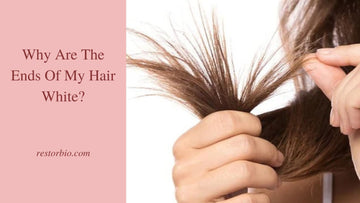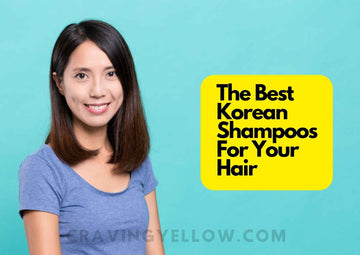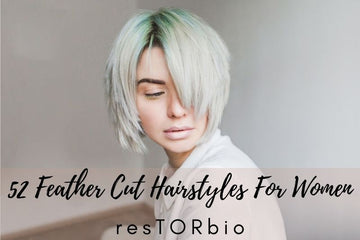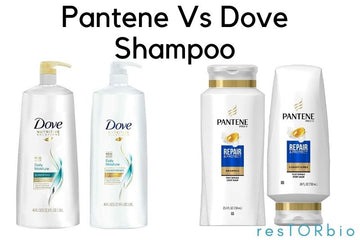
When I first discovered mine, I searched the internet for solutions. And, to my surprise, it's more common than I expected.
I haven't been to a hairdresser in a long time, and I usually cut my own hair. My split ends, on the other hand, have recently turned white. Why is cause of white ends of my hair? Could I be cutting my hair with the incorrect scissors? Is there a better technique to keep split ends at bay?
What causes white hair to grow? Contrary to popular assumption, it is not simply an indication of age. You can get it even in your early twenties (it's called premature hair whitening), but it's nothing to worry about. Premature hair whitening is a regular occurrence. What's the good news? It is entirely avoidable.
But first, before I get into the how, let's talk about why. If you assume it's because you slept with your hair wet, it probably isn't. In fact, we don't need millennia of superstition to explain this occurrence because the mechanisms of hair whitening are rather basic.

White split ends are surprisingly frequent, however seeing them on our hair can be unsettling. They are more common in longer hair. They indicate that the hair strand has been snapped, which can occur when we use heating instruments or chemical treatments too frequently. It could also be due to a lack of moisture in your hair. Giving it a good trim is a wonderful way to start getting rid of white split ends.Trimming is the most effective technique to treat damage, but make sure to follow it up with a hair care plan that works for you. Weekly hair masks can provide moisture to your hair.
Or check our guide on mixing hair dye with shampoo.
Why does hair get white in the first place? Root or Tip?
Let's start with the fundamentals. Hair follicles are small openings that go through your skin. These hair follicles give your hair its color by producing melanocytes, which produce the pigment melanin.
Your hair follicles create fewer and fewer melanocytes throughout time, causing your hair to lose pigment and turn white, silver, or gray as you age.
White hairs are much more noticeable on persons with black or brown hair (contrast, people), but lighter hair is just as likely, if not more likely, to grow white or gray.
Read also: 17 Ways to prevent aging
White hairs are generally associated with aging, however they are not timekeepers and can appear anytime they want. However, it is normal to observe white or gray hairs in your 30s or 40s.
In this essay, I'll explain what white bulb is and the most typical causes of it. I'd also mention what you can do after you've got it.
So, without further ado, let us begin.
What Is Club Hair and What Can You Do With It?

Have you ever seen the tiny white bulb at the end of your hair? Whether you have pattern baldness and are losing hair on a regular basis, or you merely have a few strands on your pillow when you wake up in the morning, you may have noticed that some of those hairs have a small white bulb at the end of them.
This white bulb at the end of the hair is known as a club hair, and it is essentially a hair with a piece of protein on the end that is designed to root the hair to the scalp.When you lose a club hair, it simply indicates you've lost a strand of hair in the telogen phase of the hair growth cycle.
Here's what you should know about that white bulb at the end of your hair:
What exactly is the white bulb at the end of your hair?
The white bulb at the tip of your hair is essentially a protein bundle known as keratin. The white bulb's function is to help the hair follicle root to the scalp, allowing the hair to grow until it is shed.
It is critical to remember that the white bulb is not the actual hair root, but rather a protein bulb present during a certain stage of the hair growth cycle. This protein bulb is the portion of the hair follicle closest to the root.
It is not unusual to lose one or two club hairs every now and then. Excessive loss of club hairs, on the other hand, may indicate that you have pattern baldness. It can also be one of the early signs and symptoms of alopecia, an autoimmune disorder that causes total hair loss.
In short, don't freak out if you notice a white bulb at the end of your hair. However, if you see these club hairs on a regular basis, you should speak with a hair restoration specialist who can help you come up with a solution that will allow you to look and feel your best.
Why does my hair fall out when I use a white light bulb?
Losing hair with a bulb at the end is entirely natural as long as it is not happening excessively or you are not noticing it on every hair strand that falls out. It simply indicates that you lost the hair during the third rather than the fourth phase of the hair development cycle.
Environmental factors can occasionally have an impact on hair loss. These are some examples:
- Hair damage caused by color dying, bleaching, or overuse of products.
- Excessive exposure to the elements, such as the sun and heat.
- Inadequate protein intake on a daily basis.
If you notice that most of your hairs are falling out with a white bulb at the end, it may be time to contact a hair restoration specialist to learn more about your alternatives.
What Should I Do If I am Experiencing Hair Loss?
It's tempting to believe that you must simply accept the new look that comes with pattern baldness, but the truth is that you have options when it comes to hair loss. Consider scalp micropigmentation if you're seeking for a hair restoration solution.
This novel method is a precise application applied to the head that creates the illusion of darker, thicker hair follicles. It is effective in treating pattern baldness, receding hair lines, and apparent scar tissue on the scalp. Scalp micropigmentation can also make hair appear fuller and thicker.
What can you do if you already have white hair tips?
Unfortunately, the only approach to treat trichorrhexis nodosa is to clip the ends and check out what's causing it.
Fortunately, the most prevalent reasons of white tips on your hair are caused by external factors like as perming, rigorous brushing, high heat treatments, UV light exposure, and chemical treatments.
If you have white tips on your hair because of heat or heat styling products, use heat protectant sprays before using one and hydrate your hair as much as possible.
How to Prevent Hair End Whitening

Purchase multivitamins.
Take multivitamins and eat a nutritious diet to ensure your body gets enough vitamins. Beef, chicken, mushrooms, and potatoes are all high in vitamins B5 and B12. Meanwhile, fatty fish like salmon and mackerel, as well as egg yolks, are high in vitamin D. Biotin can also be obtained from almonds, avocados, sweet potatoes, and salmon.
Destress
To help you relax, try meditating or practising yoga. Who can say? Yoga may even help you grow your hair! Get a decent night's sleep as well so your body can recover from a long and stressful day.
Protect your hair from the sun
White hair strands are more susceptible to sun damage caused by UVA and UVB rays. Wear a hat or a bandana to protect your hair from the sun's rays when going out throughout the day. An umbrella can also be used.
Consult your doctor
If your premature hair whitening is accompanied by other concerning signs, make an appointment with your doctor. He or she will be able to provide you with the greatest recommendations on how to deal with your symptoms.
Now that you're aware of the most prevalent hair whitening causes, you can determine whether one of them is to blame for your gray hair. You are now aware of the potential solutions. However, if you're fine with your grays, you don't need to cover them up with dye. You can shift to fashionable gray hairstyles.
Conclusion

White tips on hair typically indicate cosmetic and chemical over-treatment of the hair, a condition known as trichorrhexis nodosa.
Friction, rough brushing, excessive shampoo relaxers, swimming in salt water, and the most prevalent of all – chemical over-treatment — can all contribute to this problem.
Unfortunately, white tips are irreparable hair damage.
White hair progression can be slowed or reversed in some cases with the appropriate diagnosis and treatment. A healthy diet and proper hair care might also assist. However, in rare situations, the procedure is irreversible.
Regular usage of natural therapies may help to slow down and possibly reverse the onset of white hair. However, everyone's hair ultimately becomes white, and the individual must determine if they are fine with the white or wish to try to slow down what is a normal aging process.




